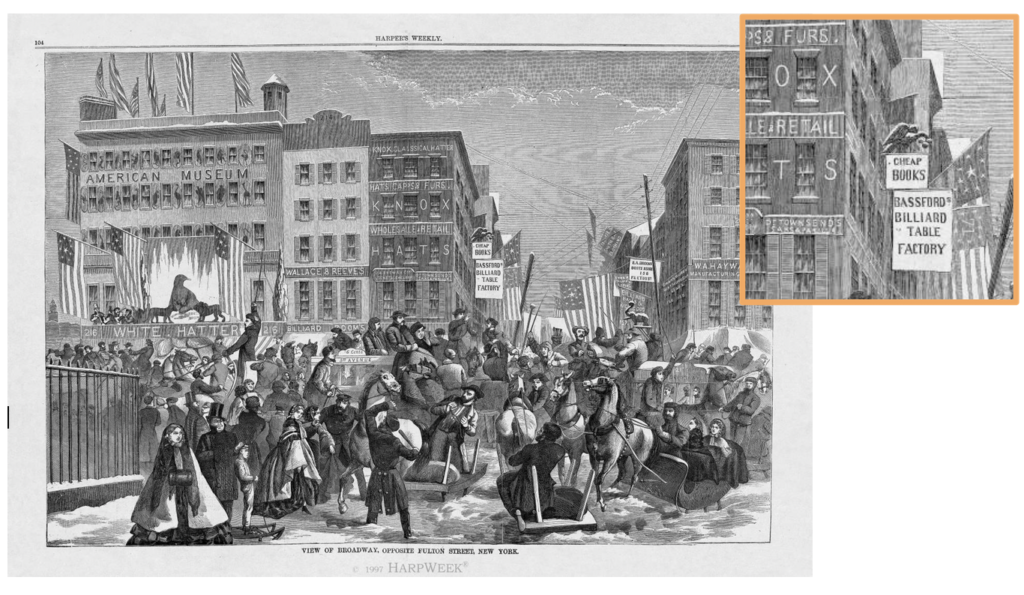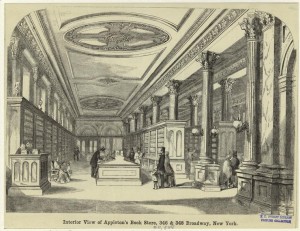
I conduct research in book culture, digital humanities, and Early American and nineteenth-century literature and culture.
Publications on Bookstores and Book Culture
The Spaces of Bookselling: Stores, Streets, and Pages
Cambridge Elements in Publishing and Book Culture. Cambridge University Press, 2023.
The material spaces of bookselling have as many stories to tell as do the books for sale. Though often overlooked as simple connecting points between people and their books, bookselling spaces help articulate cultural values of books, forms of community, and patterns of social exchange. This book focuses on three key bookselling spaces—the store, the street, and the catalogue. Spanning the nineteenth through the twenty-first century, The Spaces of Bookselling explores how bookselling spaces like the bookstore, the street table, and the catalogue have shaped and been shaped by the entrepreneurial visions of booksellers, the demands and practices of customers, and the dynamics and characters of local neighborhoods and communities.
“Gambling on a Sale: Gift Enterprise Bookselling and Communities of Print in 1850s America“
Knygotrya 78 (2022): 17-45.
This article explores the phenomenon of the gift enterprise bookstore in the mid-nineteenth-century United States. An early form of premium marketing, the gift-book enterprise promised to reward each book purchase with a surprise “gift,” ranging from pencils to dress patterns to cutlery to jewellery. A novel form of marketing books, the gift enterprise bookstore teetered on a thin line between sensation and sham. Drawing on extensive archival research on one of the most successful gift-book enterprises, the bookstores of G.G. and D.W. Evans, this article examines gift enterprise bookselling in the context of mid-nineteenth-century American print cultures. Operating bookstores in New York, Boston, Philadelphia, and Baltimore (among other places) from 1856-1861, the Evans’ also cultivated a large mail-order business. As savvy entrepreneurs, the Evans’ leveraged the national reach and perceived authority of the newspaper by engaging debates over the morality and legality of the business in the columns of widely-circulating papers and capitalizing on editorial and reprinting practices to endorse their business model and market their bookstores. In addition, in lengthy bookseller catalogues distributed across the nation, the Evans’ created a bookstore in print and shaped inclusive imagined and real communities of reader-book buyers. Examining the print culture of Evans’ gift-book enterprise offers new insights into nineteenth-century book marketing and the ways in which gift enterprise bookselling was intimately connected to, indeed, inseparable from, contemporary print forms, networks, and practices. Taking the gift-book enterprise seriously expands the histories of American bookselling and decenters the dominant focus on large publishers. In addition, the gift-bookstore demonstrates how bookselling is always entwined with larger cultural dynamics.
“Bookstores and Other Retailing”
In The Oxford History of Popular Print Culture: U.S. Popular Print Culture to 1860, edited by Ronald Zboray and Mary Zboray. Oxford: Oxford University Press, 2019.
Description of the Collection from OUP: What did most people read? Where did they get it? Where did it come from? What were its uses in its readers’ lives? How was it produced and distributed? What were its relations to the wider world of print culture? How did it develop over time? These questions are central to The Oxford History of Popular Print Culture, an ambitious nine-volume series devoted to the exploration of popular print culture in English from the beginning of the sixteenth century to the present. Volume five traces print’s role in the lives of a wide variety of people who settled—or who were displaced or forcibly transported by settlers—in middle North America, from colonial beginnings through the mid-nineteenth-century proliferation of industrially-produced imprints until 1860, when the Civil War disrupted longstanding patterns. While the volume takes account of emerging technological and economic developments in production and distribution, it nevertheless through its focus on readers emphasizes surprising continuities over the longue durée of centuries.
“Locating the Bookstore: Geographies of Book Culture in Antebellum New York City”
Book History 19 (2016): 214-255. Awarded the Book History Essay Prize.
This article explores the landscape of retail bookstores in New York City between 1820 and 1860, tracking patterns of growth and trade through original maps and examining the material and symbolic significance of the built environment of bookstores. Antebellum New York City was an incubator for the emerging forms and functions of the retail bookstore. These bookstores sold more than books—not only a wide variety of material goods, but also ideals of the book-buying consumer and models for public engagement with print. This article narrates a transition in forms of literary sociability occasioned by the material and social space of the bookstore by examining two stores operated by D. Appleton & Co. from the 1830s through the 1850s. In playing with the relationship between civic and commercial forms and values, Appleton’s stores highlight the precarious—and sometimes paradoxical—values underlying the bookstore’s ideals of public engagement with print. By layering scales—physical and social geography, the city and store, the map and narrative—“In the Bookstore” demonstrates the significance of local literary spaces to broader conceptions of book culture.
Publications on Digital Pedagogy
“Rethinking the essay: student perceptions of collaborative digital multimodal composition in the college classroom”
Co-authored with Dr. Jana Fedtke. Higher Education Pedagogies 8:1 (2023).
“Rethinking the essay” urges a reconsideration of the traditional essay in undergraduate education. Despite renewed critiques of the efficacy of the essay as a pedagogical and assessment tool, the essay stubbornly retains primacy in higher education. Taking these critiques into consideration as well as the challenges associated with introducing new assessment modes in classrooms, this study examines student perceptions of a collaborative digital multimodal writing project as an alternative to the traditional essay. The case study focuses on the perceptions and experiences of 35 students in two advanced undergraduate literary studies courses who were assigned a collaborative digital multimodal composition project in the online publishing platform, Scalar. Narrative and thematic analysis of student reflections indicates that students, while initially anxious about departing from the familiarity of the essay, most value the increased creativity and digital writing experience afforded by multimodal composition. In addition, students perceive enhanced knowledge production and increased respect for the contributions of peers. Results indicate that students equate “academic writing” with the essay, so additional work should be done to emphasize specific academic writing and discipline-specific skills. Collaborative digital multimodal composition can be adapted across diverse fields of study and has the potential to transform the staid essay into a creative, collaborative, and ethical mode of teaching, learning, and assessment.
“Integrating Technology for Reading and Writing in the EFL/ESL Classroom.”
Co-authored with Philip McCarthy and Khawlah Ahmed. In TESOL in the 21st Century: Challenges and Opportunities, edited by Zubeyde Sinem Genc and Isıl Gunseli Kacar. New York: Peter Lang, 2021
Digital technologies are fast becoming one of the realities in academia in the 21st century. Such technology-mediated environments demand new approaches to teaching and learning. With these new approaches, it is important that we not only address the skills but also the concerns, both technical and ethical. This chapter focuses on technology for reading and writing skills in the ESL classroom and examines education technology applications in recent developments in digital media, software, and both web-based and open-source tools. It discusses the benefits and challenges of using various applications of technology, providing an overview of relevant tools that focus on reading, annotation, writing, revising, and even materials development. The chapter offers individuals working in education (be they researchers, instructors, or curriculum developers) information and suggestions on how technological tools may be used to assist in the goal of enhancing student learning.
Projects in Development
In the Bookstore: Local Literary Spaces in Antebellum New York City
(Manuscript in development)
This book offers the first extended study of the history and social life of the bookstore in nineteenth-century America. Located between producers and consumers of books, the bookstore was a crucial site in the cultural geography of print and literacy in nineteenth-century urban America. Where were the bookstores? How did booksellers position their stores in the larger print marketplace? How were bookstores perceived and used by their customers? The bookstore—as building, business, and social space—negotiated questions of access, textual and generic value, as well as promoted models of literary and market engagement. To explore these and related issues, I pursue literary history from the perspective of the physical and cultural space of the bookstore. Developing original methods for analyzing print and literary culture, this project uses the bookstore as the foundation for insights into three related areas: the commercial geography of print in nineteenth-century New York; the social history of literature, taste, and values; and the intellectual history of information technology.
The Illustrated Charlotte Temple
Co-authored by Spencer D. K. Keralis. Under contract with Illinois Open Publishing Network, University of Illinois, Urbana-Champaign. Estimated 2024.
Charlotte Temple: A Tale of Truth was America’s first bestseller and one of its most consistently in-print novels. A mainstay of university classrooms today, this novel has been published in over 200 editions since its original American publication in 1794, many of them illustrated editions. The Illustrated Charlotte Temple seeks to bring Charlotte Temple into the twenty-first century and takes advantage of the affordances of digital multimedia publication to expand and enrich understanding and scholarship on this essential American novel and on the print culture contexts surrounding its long publication life. Charlotte Temple lived through the growth of regional printers and then urban publishing houses, through the shift from handcut wood engraving to mechanical chromolithography, and through the rise of mass print publishing and sophisticated marketing strategies. These editions are thus material evidence of technological and media transition. By compiling bibliographic information on these illustrated editions and their printers and publishers, and offering critical commentary on the forms and readers of the novel, this digital compendium, published using Scalar’s open-source digital publishing platform, offers a rich archive for scholars and students to study the novel and literary and print culture in nineteenth and early twentieth-century America.
Additional Publications
“The Things They Collected.” Review of In Pursuit of a Vision: Two Centuries of Collecting at the American Antiquarian Society, an exhibition at the Grolier Club, September 12-November 17, 2012. Common-Place, 13:2.5 (March 2013).
Review of Joan Shelley Rubin, Songs of Ourselves: The Uses of Poetry in America in SHARP News,Vol. 19, No. 1. (2010), p4.
“Gotham: The Other New York” in Lost New York: 1609-2009, an essay volume accompanying an exhibition and conference at New York University (2010).
